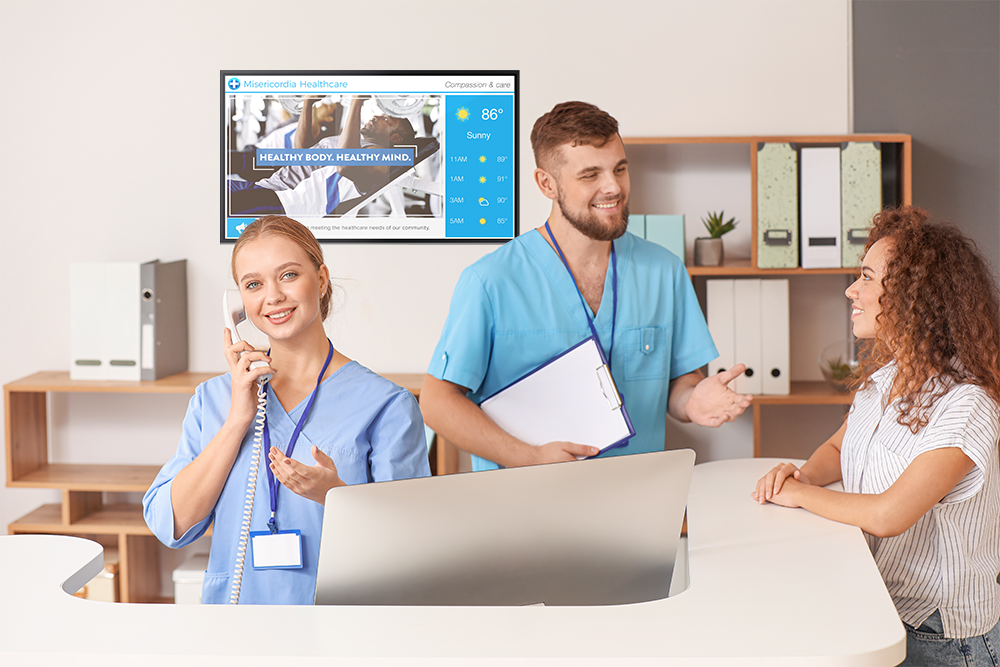Take a minute to look at or visualize your healthcare practice. What do you see?
Do you see a modern, sleek office that shows your patients you care about providing the best care and experience possible by keeping up with the latest technologies and trends in your industry?
Or do you see an outdated office with an old-school approach to managing and interacting with patients, a boring waiting room, and tired exam rooms that haven’t changed in years?
If you have the former, congrats. You are keeping up with the times and providing your patients with what they want: an upgraded, engaging office that makes their visit a pleasant one.
But if you have the latter, it’s time to consider a change.
Thankfully, the improvement process is not as difficult, costly, or time-consuming as you think. You can quickly enhance the atmosphere and appearance of your healthcare practice with one simple element: digital signage.
What Is Digital Signage?
Digital signage is a series of media display screens placed throughout your healthcare office to provide support for your staff, create an engaging experience for patients, enhance wellness initiatives, and create a safer and more productive work environment.
Digital signage includes:
- Interactive Kiosks
- Touch Screen Portals
- Digital Information Boards
- Custom Video Production
- Private Label Television
- Interactive Wayfinding Tools
- Video Screens
From building entrances and hallways to employee workstations and waiting and exam rooms, digital signage can be placed throughout a healthcare practice.
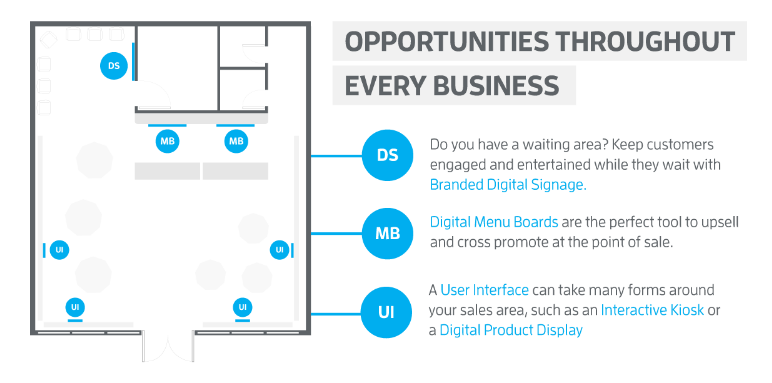 The addition of digital media platforms immediately upgrades the appearance of a healthcare facility, but it does more than add an aesthetic upgrade to your office. Digital signs for healthcare improve patient experience, enhance your communication and marketing efforts, and benefit patients, staff, and your practice.
The addition of digital media platforms immediately upgrades the appearance of a healthcare facility, but it does more than add an aesthetic upgrade to your office. Digital signs for healthcare improve patient experience, enhance your communication and marketing efforts, and benefit patients, staff, and your practice.
Here’s how.
How Does Digital Signage Benefit Patients?
- Speeds up patient intakes. Waiting for appointment intakes can be a frustrating process for patients. Through the use of interactive intake kiosks, patients can accelerate their intake process. Instead of waiting for in-person assistance, they can immediately use the platform to check-in, update records, schedule future appointments, manage and pay bills, and even print reminders, receipts, and other important documents.
- Decreases perceived wait time. When digital screens with engaging content are added to waiting rooms, it decreases the perceived wait time for patients. A 30-minute wait can feel more like a 20-minute wait when patients are watching high-quality content that is targeted to their wants and needs.
- Eases anxiety about appointments. Entertainment in healthcare practice waiting rooms does more than decrease perceived wait time. It also helps ease the mind of your patients. Providing upbeat, entertaining, and engaging content helps reduce the nervousness and anxiety of waiting patients, making them more relaxed before their appointment.
- Shares important health-related information. The content you share in your office doesn’t always have to be strictly entertaining. You can also use digital media to share educational content such as wellness tips, treatment procedures, and medical advice that will keep your patients healthier.
- Helps patients find their way faster. If your practice is located in a large building or includes many offices, it can be confusing for visitors to navigate. You can alleviate this complication by using interactive maps and directories near the entrance to your location. Unlike static maps, this interactive tool condenses and personalizes information so your visitors only see the information they need, which helps them find their way easier and faster.
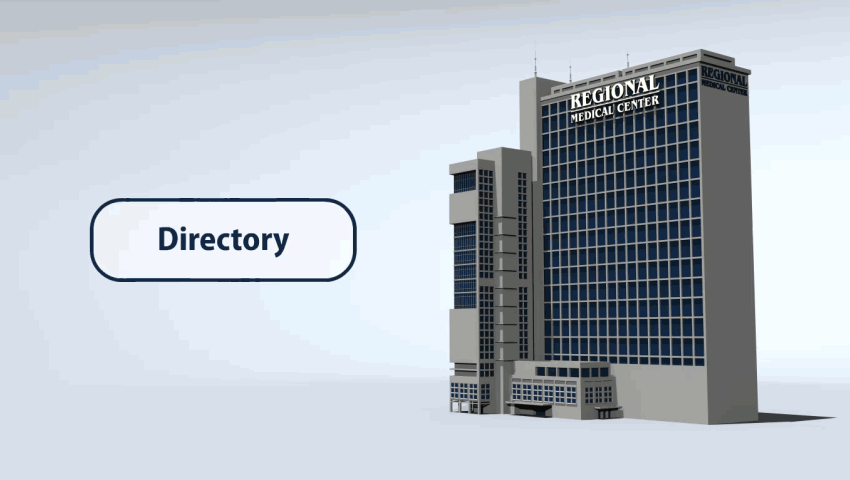
- Creates a connection to staff. The healthcare business is a personal industry and patients like to know who they are working with. Digital signage gives you an opportunity to introduce your patients to your team in a compelling way. You can create staff introduction videos that show both the professional accolades and personality of your team to help build a stronger, more trusting relationship with your patients.
- Communicates with loved ones. Digital signs aren’t limited to patient-facing content. You can also use digital screens to connect with the family or loved ones of your patients. Information screens can be placed in visitor waiting rooms to provide updates and notifications for waiting loved ones.
How Does Digital Signage Benefit Staff?
- Reduces strain on human resources. Digital tools help free up human resources and decrease the stress on your staff. Instead of extending human resources, you can use kiosks for patient intakes and scheduling and utilize interactive wayfinding tools to help guide new visitors.
- Provides consistent staff training. Your healthcare practice can create videos to train new employees. This ensures consistent employee training and also alleviates a strain on human resources. Trainers can record one training session instead of repeating it in-person over and over.
- Provides recurring staff training. Training videos serve double duty. They help introduce new staff to policies and procedures, and they also help seasoned staff refresh their knowledge. Through digital signage tools, you can provide your staff with a portal of resources they can use anytime they need to revisit training material.
- Organizes internal info, client intakes, rotation, and care. Staff-facing digital screens provide improved internal communication. Signage can share information on patient status, staff scheduling, among other important communications. In a large office or building, digital signs throughout the location can share the same message ensuring that your staff is always on the same page.
- Empowers staff. An accelerated, connected, and effective communication and training system provided through digital media puts employees in a better position to succeed. By providing easy access to the information they need, digital tools make it easier for staff to do their job and feel better about the results of their work.
- Decreases hallway congestion. When interactive wayfinding tools are in place, patients can find their way faster. This decreases the amount of foot-traffic in hallways. Having less congestion in hallways allows staff to get where they need to go faster and with less resistance as they won’t need to guide visitors and lost patients.
- Delivers emergency information. Digital screens placed throughout an office connect the entire property. The information can be synced so the same notification is posted on all screens. This is extremely helpful in the event of an emergency such as a fire, security breach, or national health event. Emergency directions can be shared with everyone in the location through the use of one centralized platform.
How Does Digital Signage Benefit a Healthcare Practice?
- Promotes services and products. Content shared through your digital platforms is meant to engage, entertain, and educate your audience. But content can also work for your business. You can add messages that spread awareness about your products and services, share promotions, and promote upcoming events or news.
- Highlights awareness initiatives. Digital signage is great for spreading awareness, which makes it an ideal platform for promoting healthcare awareness programs. Because digital signage content is simple to update, you can regularly change your content to highlight daily and monthly healthcare awareness issues that relate to your patients.
- Creates a cohesive brand. You want to brand your healthcare practice so it stands out from competitors and resonates in the minds of your patients. Digital tools, such as private label tv and custom signage wraps, can help you promote and reinforce your brand so your messaging is memorable and powerful.
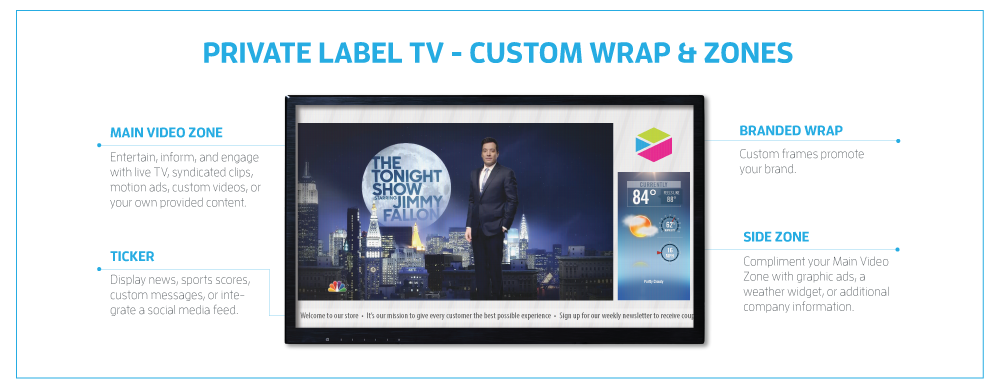
- Captures patient data. If you want to gather information about your patients and learn more about their needs and wants, you can collect that data through interactive content. Digital portals enable users to control and interact with content, so you can add features where users provide data such as their preferences on topics, online contact information, and more.
- Decreases cost of marketing materials. When you use digital media marketing materials, you will never need to order new versions of posters and signage. Instead of spending money on new materials, you can simply update your signage by using simple content management tools.
- Eliminates competitor’s advertisements and offensive content. When you use custom content playlists or private lable television programs for your in-office content, you are in control. You set the playlists so you know what content will be airing. You can ensure that offensive programming doesn’t show (as it can when regular television channels are on) and that competitor advertisements don’t air while your patients are waiting in your office.
- Promotes referral marketing programs. Digital media is an effective way for capturing audience attention, so it is an ideal place to share information about your referral programs. You can use your digital signage to inform your patients about how to sign up for your programs and educate them on how it will benefit them.
What Healthcare Practices Can Reap these Benefits?
The benefits of digital signage can serve a variety of healthcare facilities and practices.
Private Healthcare Practices
Single physicians and specialists can use digital signage to engage and entertain patients in their waiting area, to communicate with staff in employee areas, and to allow patients to sign-in or make updates to their information and appointment dates.
Group Healthcare Practices
Group practices with multiple practitioners can use digital signage to help patients find the rooms and doctors they need. They can also use in-office signage to educate (and entertain) patients in waiting areas or examination rooms.
Hospitals / Medical Campuses
Hospitals and large medical campuses can use digital wayfinding tools to help patients and their loved ones navigate the large location. It can also provide content to waiting patients and guests as well as notify the entire campus of any emergencies or important notifications.
Urgent Care Offices
Urgent care offices can use digital signs to help walk-in patients view pricing and service options on menu boards. They can also set up waiting room TV screens to help patients pass the time and learn about the practice and healthcare initiatives (like getting flu shots or sports physicals).
Dental Offices
Dental offices can set up digital waitboards in their waiting area to decrease patient stress and anxiety leading up to their appointment. The signage can also be used to provide information about dental care and showcase different services from the practice.
What This Means for Your Practice
As you can see, using digital signs can elevate healthcare practices in a variety of ways. It improves your marketing and communications plans and benefits patients, staff, and your practice as a whole.
And, this upgrade is fairly easy to implement. The following checklist will walk you through the items you need to bring digital signs to your healthcare practice.
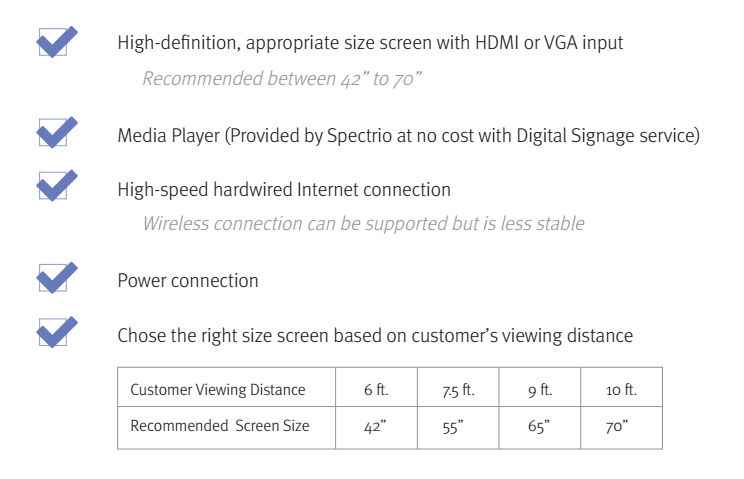
Now that you have seen how digital signs can improve your healthcare practice and what you need to have to bring it to your office — what questions do you have about implementing this upgrade at your office? Get all of your questions answered by asking us directly.
We’ll give you all of the details on using digital signage in your healthcare practice during a free, no-obligation consultation. Schedule a demo with Spectrio today to see what you need to start using digital screens and bring these 21 benefits to your office.
